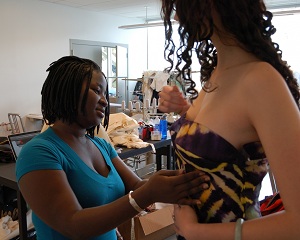Frederick Ochanda, postdoctoral associate in Cornell's Department of Fiber Science&Apparel Design and a native of Kenya, teamed up with Matilda Ceesay, a Cornell apparel design undergraduate from Gambia, to create a hooded bodysuit embedded at the molecular level with insecticides for warding off mosquitoes infected with malaria, a disease estimated to kill 655,000 people annually on the continent.
Insecticide-treated nets are commonly used to keep mosquitoes out of African homes but those are not practical to wear during the day - and they say the Cornell prototype garment does not dissipate easily like skin-based repellants. By binding repellant and fabric at the nanolevel using metal organic framework molecules, clustered crystalline compounds, the mesh fabric can be loaded with up to three times more insecticide than normal fibrous nets, which usually wear off after about six months.
"The bond on our fabric is very difficult to break," said Ochanda. "The nets in use now are dipped in a solution and not bonded in this way, so their effectiveness doesn't last very long."
 |  |
The colorful garment debuted on the runway at the Cornell Fashion Collective spring fashion show April 28 on the Cornell campus. It consists of an underlying one-piece body suit, hand-dyed in vibrant hues of purple, gold and blue, and a mesh hood and cape containing the repellant. The outfit is one of six in Ceesay's collection, which she said "explores and modernizes traditional African silhouettes and textiles by embracing the strength and sexuality of the modern woman."
Whatever that means to epidemiology. The 10 African women who can afford it will be pleased their anti-malaria suit embraces their sexuality, though. Still, they are trying so they deserve credit for that. Both have watched family members suffer from the disease.
"Seeing malaria's effect on people in Kenya, it's very important for me to apply fiber science to help this problem," Ochanda said. "A long-term goal of science is to be able to come up with solutions to help protect human health and life, so this project is very fulfilling for me."
Of course, science did that with DDT but anecdotes about how a woman got cancer and died from it - which savvy voters of today don't fall for (as Michele Bachmann learning throwing out anecdotes about the HPV vaccine) - became gospel to a generation and the following ones have not even read Rachel Carson's book but assume it was based in fact.
On the horizon, Ochanda said, is a fabric that releases repellant in response to changes in temperature or light – offering wearers more protection at night when mosquitoes are on the hunt. At minimum, they hope the technology can be applied to create longer-lasting insecticide-laden bed nets.
"Although there are already mosquito nets being used, the solution isn't foolproof," Ceesay said. "People are still getting sick and dying. We can't get complacent. I hope my design can show what is possible when you bring together fashion and science and will inspire others to keep improving the technology. If a student at Cornell can do this, imagine how far it could go."






Comments